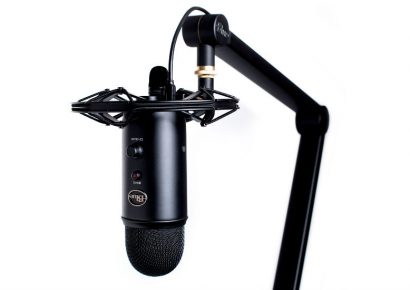The HypeMiC aesthetically resembles the MiC+ and previous Apogee USB mics with its dull gold finish and lightweight build. The mic is only part of the package here with a pop filter, desktop stand and mic stand adaptor packed into a hard fabric carry case inside. The pop filter is a cute size but its stand is quite stiff, making it frustrating for use outside the home studio. The carry case bears a neat Apogee pop-up insignia and fits in a backpack without fuss — a hardier leather case would have been welcome but it should wear light travel well. Apogee’s buddy up with Apple is clear out of the box too with the inclusion of a Micro B-to-Lightning cable alongside the usual USB-C and USB-A.
What makes the HypeMiC remarkable is its built-in analogue compressor of a quality normally found in extortionately priced studio condenser mics, now in a tiny USB package. The technological leap impressed vendors at this year’s NAMM who expected a banal revamp of the Mic+.The compressed clarity is still faithfully converted into audio via Apogee’s patented PureDIGITAL connection (24-bit sample rate and 96kHz resolution).
The mic offers three simple modes of compression: Shape It, Squeeze It and Smash It, toggled on the front panel by the control knob. Shape It, the minimal amount of compression, will suit most of your musical needs, while Squeeze It is predominantly for podcasting and interviewing. Smash It is Rick Rubin’s trademark compression on crack, suited to the bombast of a single voice broadcast. I found Squeeze It also worked well for recording quieter, auxiliary percussion. The capsule design rejects sound from the opposite side of the mic which, in conjunction with the pop filter, rendered background interference invisible. Changing mic gain is as simple as twiddling the same control knob while information about levels and compression setting is plainly indicated by a three light LED — blue indicates connection to power, green a connection to a DAW or audio program that is ready to record.
No metaphor is needed to illustrate the simplicity of the USB connection either; within a minute of taking the mic out of the box, I had plugged in the lightning cable to my laptop, opened Adobe Audition and hit record without configuration. The HypeMiC is highly compatible with GarageBand for iOS too, heightening its portability. This is valuable for journalists in the field, though if you’re using it handheld it’s advised the Shape It setting is used to prevent popping and hiss. Without the pop filter however compression is mostly too sensitive to use for an audio interview recorded on the street. The simple 3.5mm headphone output is worth mentioning too; the second button on the front panel engages the Blend function, controlling balance between the HypeMiC and playback signal for zero latency recording.
The minimal settings with their goofy names panders to an audience getting into the world of home recording or podcasting, though the audio geek in me yearns for greater customisation. It’s a greedy thought though, spurred by the quality of the tech in the compact package. The condensing of the analogue compressor is staggering, though the price tag makes its beginner-targeted marketing slightly confusing. The HypeMiC is a near perfect podcast mic and a garden-variety excellent microphone for musicians.

